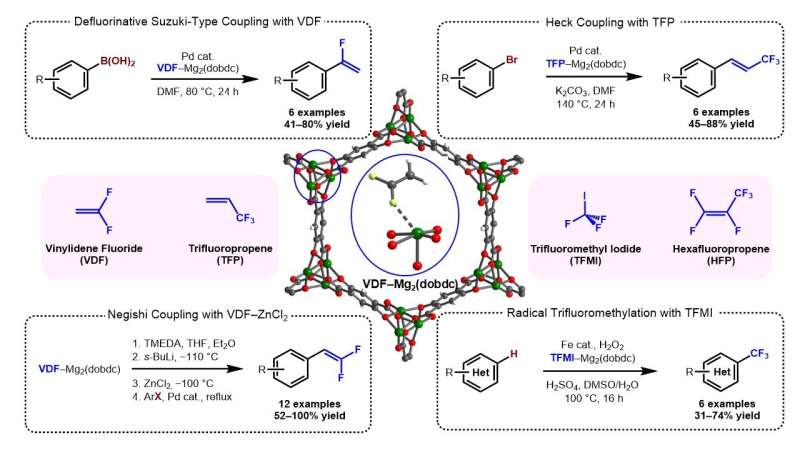October 6, 2023 report
This article has been reviewed according to Science X's editorial process and policies. Editors have highlighted the following attributes while ensuring the content's credibility:
fact-checked
peer-reviewed publication
trusted source
proofread
Using metal organic frameworks to provide a safer and cleaner way to handle fluorinated gases

A team of chemists from Cornell University, the Korea Institute of Science and Technology and Southern Methodist University, has found a way to use metal organic frameworks to provide a safer and cleaner way to handle fluorinated gases. Their study is reported in the journal Science.
Gaseous fluorocarbons are known to be hazardous reagents, which can make them particularly challenging to deliver and use, requiring special equipment. They are also flammable and toxic. And when released into the atmosphere, they deplete ozone. Thus, it has been known for quite some time that a better means for handling and storing them is needed.
In looking for a better way to deal with fluorinated gases, the research team knew they were going to need a special kind of material to hold it, one that was porous and had a high gas sorption capacity. They also knew it would need to interact with the gases they contained to keep the gas from leaking out—and it would have to remain stable for reasonable amounts of time. That led them to test the uptake of one type of fluoride (vinylidene) in 12 particular MOFs. MOFs are compounds made of clusters of coordinated organic ligands with different types of structures.
They found one called Mg2 that appeared to be an ideal candidate—it had both high capacity and strong interactions with multiple fluorides. It also was durable and stable—it could be left on a benchtop for a week and still be viable. They also noted that any gases it contained could be easily released when needed by submersion in a solvent. When they created gas-MOF reagents, they found that they could contain a gas for up to a week without leaking. They also found that if they embedded them in wax, then the gases could be safely held for up to two months. Accessing them required nothing more than applying sonication.
More information: Kaitlyn T. Keasler et al, Handling fluorinated gases as solid reagents using metal-organic frameworks, Science (2023). DOI: 10.1126/science.adg8835
Journal information: Science
© 2023 Science X Network





















